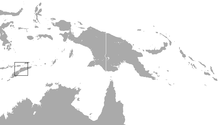Timorese horseshoe bat
The Timorese horseshoe bat (Rhinolophus montanus) is a species of bat native to Timor-Leste.
| Timorese horseshoe bat | |
|---|---|
| Scientific classification | |
| Kingdom: | Animalia |
| Phylum: | Chordata |
| Class: | Mammalia |
| Order: | Chiroptera |
| Family: | Rhinolophidae |
| Genus: | Rhinolophus |
| Species: | R. montanus |
| Binomial name | |
| Rhinolophus montanus Goodwin, 1979 | |
 | |
| Timorese horseshoe bat's range | |
| Synonyms | |
| |
Taxonomy and etymology
It was described as a subspecies of the large-eared horseshoe bat by Robert Goodwin in 1979. Its trinomen was Rhinolophus philippinensis montanus.[2] It was maintained as a subspecies until 2002, when Csorba argued that it was morphologically distinct enough to be considered a full species.[3] Since this publication, it has consistently been considered its own species, Rhinolophus montanus. Its species name "montanus" is Latin in origin, meaning "montane." Goodwin chose this species name because the holotype was found at a high elevation of 1,220 m (4,000 ft) above sea level.[2]
Biology
It is nocturnal, roosting in sheltered places during the day such as caves. Unlike some bat species which are highly colonial, it roosts in small groups of perhaps 6 or 7 individuals. When roosting, it prefers to hang from the ceilings of caves rather than in crevices. Individuals are well-spaced during roosting rather than clustered. It has been roosting with other species of bat, including Creagh's horseshoe bat, the western bent-winged bat, and the small bent-winged bat.[2]
Range and habitat
The holotype, paratype, and two additional specimens were all collected from Quoto Lou Caves in Timor-Leste, about 1,220 metres (4,000 ft) above sea level. These caves are not natural, and were excavated by the Japanese during their occupation of East Timor. The caves are located near Ermera.[2] There have been additional acoustic detections near Laleia, Nino Konis Santana National Park, and Betano.[1]
Conservation
It is currently assessed as endangered by the IUCN, indicating that it is at risk of going extinct. It meets the criteria for this assessment because its area of occupancy is smaller than 500 km2 (190 sq mi), and it is threatened by habitat destruction and human disturbance of its roosts.[1]
References
- Armstrong, K.; Csorba, G. (2016). "Rhinolophus montanus". The IUCN Red List of Threatened Species. 2016: e.T136248A22003364. doi:10.2305/IUCN.UK.2016-2.RLTS.T136248A22003364.en.
- Goodwin, R. E. (1979). "The bats of Timor: systematics and ecology". Bulletin of the AMNH. 163 (2): 112–113. hdl:2246/1288.
- Csorba, G. (2002). "Remarks on some types of the genus Rhinolophus (Mammalia, Chiroptera)" (PDF). Annales Historico-naturales Musei Nationalis Hungarici. 94: 217–226.
